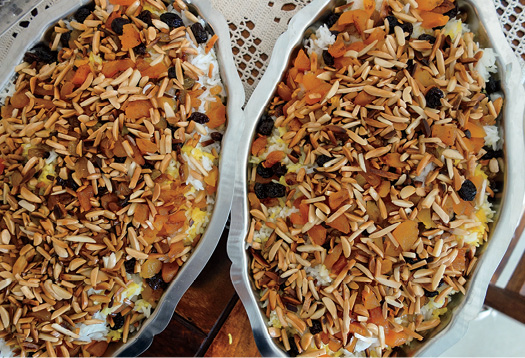
Rice Pilaf
“The beauty of the pilaf method is that it manages to pack the rice with flavor while maintaining the integrity of individual grains.”
Without a doubt, pilaf is my favorite way to prepare rice. The method takes something as plain as steamed rice and turns it into party time with a handful of ingredients that even a poor, overworked cook would have in his or her home kitchen. The beauty of the pilaf method is that it manages to pack the rice with flavor while maintaining the integrity of the individual grains. Every step in the process is specifically designed to achieve this platonic ideal.
I prefer jasmine rice for its firm texture and the small size of the grains. First I wash the rice to remove excess starch that will cause the grains to stick together. Then I soak the rice to shorten the cooking time, so the interior of the grain finishes cooking before the exterior begins to fall apart. And I toast the rice in oil or fat before adding the liquid; this coats each grain in a protective jacket that helps it retain its individuality. Finally, I cook the rice in the gentle, even heat of the oven, rather than the violent bottom-up heat of the stovetop.
When we first opened Zahav, I imagined that we would make rice in batches throughout the night, which would allow us to serve the freshest rice possible. Before dinner service, we would make up kits of premeasured rice, water, and seasonings to have ready when called upon. Besides being completely impractical in a busy restaurant, I quickly realized that this idea actually did a huge disservice to the rice: Rice needs to rest after it’s cooked. The moisture needs time to evenly distribute throughout the grain and the starch needs time to set up—if you handle rice too quickly after cooking, the grains easily break apart and you can end up with a gluey mess. I recommend resting it for at least 15 to 20 minutes, or longer if you have the time and patience. (Avi will sometimes wrap a pot of finished rice in a towel and leave it for hours to cool down completely.)
Another advantage of the pilaf method is it gives you three opportunities to add flavor: toasting the rice; choosing the cooking liquid itself; and fluffing and seasoning the rice before serving. The recipes are far less important than the technique.
At home rice pilaf is a great thing to make when you think you have absolutely nothing to eat in your kitchen. Thinly slice those last few stalks of celery in the bottom of your vegetable bin and sauté them in olive oil with some garlic while toasting the rice. Add a package of frozen peas on top while the rice is cooling (covered) and finish with grated Parmesan cheese. Even leftover orange juice or V8 (or both together) will give you intensely flavored rice. And if you brown some ground beef before you add the rice, you’ll have a soulful one-pot meal. Fold a handful of sunflower seeds and raisins (rehydrated in water) from the back of your pantry into a rested pilaf to create an addictive sweet and salty pot of rice fit for royalty. Once you master the technique, you’ll likely never settle for plain steamed rice again.
